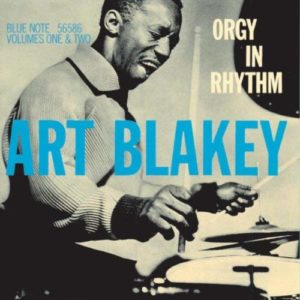Today I’m starting a new weekly series. When I created this website I called it “Looking for a Rabbit Hole” for a reason. Along with being a place to showcase some of my writing it was also supposed to be a place for me to talk about all the various bits of entertainment I like to lose myself in. I love stories in all the forms stories take, and I love music, and I love talking about stories and music. To that end I’m working up some on-going features I’d like to have here on the blog where I talk about the “Rabbit Holes” of story and music I’m losing myself in whether new, new-to-me, or old favorites.
This series then, “The Jazz Chain”, will be the first of these projects.
I began really listening to jazz in earnest about the same time I started writing, about 6 years ago. The connection was quite simple: I like to listen to music when I write but I can’t write to music that has lyrics.1Or at least not to lyrics I can understand – looking at you Sigur Rós. Instrumental jazz and electronic music became my listening go-tos for when I’m writing.
I found the world of jazz music, particularly of the 50s, 60s and 70s very appealing and started building up a little digital jazz collection of my own. One of the things I most loved discovering about jazz was the fluidity of the musicians – how they would move from working with one group of musicians to another and how on any given album the supporting players were likely to have some, if not many, albums under their belt as band-leaders in their own right. The first time I recognized that I was hearing Lee Morgan playing on an Art Blakey album I felt pretty proud of myself.2I’ll be honest, such revelations while listening are rare for me, I’m neither that knowledgeable nor is my ear that talented. I most often find out I’m familiar with a supporting player after I look up info about the album, not on first listening.
This ever shifting landscape of great jazz musicians is the basis of this blog project. I am going to go on a tour through jazz and forge my own personal chain of jazz-listening experience, and you are welcome to come along.
The process is fairly simple. I start today with one of my favorite albums: Art Blakey’s Orgy in Rhythm. I’ll give my (totally not expert, you’ve been warned) opinion and thoughts on the album. Then I’ll choose one of the “sidemen” on the album, check out their discography, and choose a new album3My preference will be to select an album where my chosen musician is the band leader, but I’ll accept another sideman role if I have to. to use as the subject of the next week’s installment of “The Jazz Chain”. How long can the chain get? Personally, I suspect I’ll able to carry on nearly indefinitely without painting myself into a corner and running out of new musicians to move my focus to, but trying to prove that is going to be one of the interesting things about this quest.
Now, with that long introductory explanation out of the way let’s move on to the first album in The Jazz Chain:
Orgy in Rhythm – Art Blakey – 1957
The first thing you need to know is that I’m a sucker for a great album name. I’m a big fan of Blakey and have several of his albums and strictly speaking A Night in Tunisia is probably my favorite, but how can I pass up the chance to start the chain with something called Orgy in Rhythm?
The second thing you need to know is that Orgy in Rhythm was record as one session originally released as two albums and later re-released as one complete album. You can sometimes find the complete version as just Orgy in Rhythm or Orgy in Rhythm Vol. 1 & 2. If you’re going to listen then go for the complete version, however it’s named.
The third thing to keep in mind is I consider Art Blakey one of the all time greatest drummers, maybe even the greatest, to have ever lived.4Of course, this is a good time to remember that “Not really an expert opinion” thing. Listening to Blakey for the first time is like listening to John Bonham for the first time: revelatory. For visual proof I offer into evidence this recording of an Art Blakey drum solo from 1959, a couple years after the album in question.
That same signature sound is all over this album. It could not be more aptly named. Percussion is everything here. The tracks are long but never boring, never meandering. Blakey’s group grabs you and doesn’t really let go until the ride’s over.
They are kind enough to ease you into the orgy though. The first 2:42 of the opening track, “Buhaina Chant”, is steady and almost meditative with flute and, yes, chant. But a second later Blakey explodes in force and the album begins in earnest. It doesn’t really let down the energy for any significant length of time again (though it’s not all loud and fast either) until the lovely “Elephant Walk”, though even there the orgy threatens to break back out into full swing.
Following that, the last two tracks include the fun “Come Out and Meet Me Tonight”5A song which breaks my ‘no lyrics I can understand’ rule, but if I’m writing to this album by the time we get here I find this song is a great reminder to come up for air, get out of the chair and take a little break. and “Abdallah’s Delight” which perfectly brings the party to a close with something of a relaxing, almost ‘cool jazz’, flavor.
I’m a fan of how upbeat this whole album often feels with not only “Come Out and Meet Me Tonight” but other tracks like “Ya Ya” and “Toffi” making this party feel like a welcoming and fun one to be part of. The only track that really threatens to go off the rails into just too much percussive noise territory is the aptly named “Amuck” but as it builds off the similar nature of the preceding track “Split Skins” and leads into the quiet beginning of “Elephant Walk” it actually serves a strong purpose on the album as a whole listening experience, even if I wouldn’t necessarily queue it up to listen to on its own.
And that’s the final thing I want to highlight about Orgy in Rhythm. Unlike quite a few jazz (and other genres!) albums I’ve listened to this feels like a true album. Its parts go together and the total of the listening experience from beginning to end is greater than the sum of its parts, even if some of those individual parts are quite good tracks all on their own.
There are 10 musicians other than Art Blakey credited on this album and I’ve decided to select Sabu Martinez, another percussionist also credited for the vocals on “Buhaina Chant”, “Elephant Walk” and “Come Out and Meet Me Tonight”, and his album Sorcery! for the next link in The Jazz Chain. Until then, go enjoy some music.

